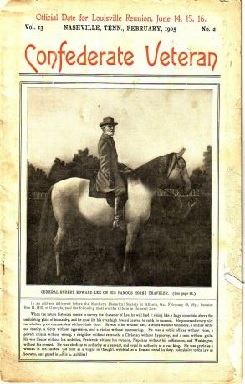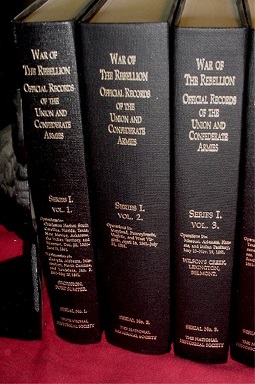The Shenandoah, or the Last Confederate Cruiser
by Cornelius E. Hunt
273 pgs.
The CSS Shenandoah, formerly Sea King and later El Majidi, was an iron-framed, teak-planked, full-rigged sailing ship with auxiliary steam power chiefly known for her actions under Lieutenant Commander James Waddell as part of the Confederate States Navy.
Shenandoah was originally a British merchant ship launched as Sea King on August 17, 1863, but was later repurposed as one of the most feared commerce raiders in the Confederate Navy. For twelve-and-a-half months from 1864 to 1865, the ship undertook commerce raiding around the world in an effort to disrupt the Union's economy, capturing and sinking or bonding 38 merchant vessels, mostly whaling ships from New Bedford, Massachusetts. She finally surrendered on the River Mersey, Liverpool, United Kingdom, on November 6, 1865, six months after the war had ended.
The Shenandoah is also known for having fired the last shot of the Civil War, across the bow of a whaler in waters off the Aleutian Islands.
History and mission
The ship had three names and many owners in her lifetime of nine years. She was designed as an auxiliary composite passenger cargo ship of 1,018 tons and built in 1863 by Alexander Stephen & Sons, Glasgow, Scotland, for Robertson & Co., Glasgow, to be named Sea King. The ship was intended for the East Asia tea trade and as a troop transport. While she was being fitted out at the builders, US representatives assessed the ship for purchase. After change of owner and a number of trips to the Far East carrying cargo and to New Zealand transporting troops to the New Zealand Wars, the Confederate navy assessed and purchased her from Wallace Bros of Liverpool. The purchase, made in secret, was completed on 18 October 1864, and the next day the ship was renamed CSS Shenandoah. The ship was to be converted into an armed cruiser with a mission to capture and destroy Union merchant ships. Liverpool was the unofficial home port of the Confederate overseas fleet, and Confederate Commander James Dunwoody Bulloch was based in the city. The city provided ships, crews, munitions, and provisions of war.
Sea King sailed from London on 8 October 1864, ostensibly for Bombay on a trading voyage. The supply steamer Laurel sailed from Liverpool the same day. The two ships rendezvoused at Funchal, Madeira, with Laurel carrying the officers and the nucleus of Shenandoah's crew, together with naval guns, ammunition, and ship's stores. Shenandoah's commander, Lieutenant James Iredell Waddell, supervised her conversion to a man-of-war in nearby waters. However, Waddell was barely able to bring his crew to even half strength, despite additional volunteers from the merchant sailors on Sea King and from Laurel.
The new Confederate cruiser was commissioned on 19 October 1864, lowering the Union Jack and raising the "Stainless Banner", and was renamed CSS Shenandoah.
As developed in the Confederate Navy Department and by its agents in Europe, Shenandoah was tasked to strike at the Union's economy and "seek out and utterly destroy" commerce in areas yet undisturbed. Captain Waddell began seeking enemy merchant ships on the Indian Ocean route between the Cape of Good Hope and Australia, and in the Pacific whaling fleet. En route to the Cape, the Confederates captured six prizes. Five were burned or scuttled, after the crew and passengers had been removed. The sixth was bonded and used to transport the prisoners to Bahia, Brazil, where they were released. On the 2 January 1865, the Shenandoah briefly stopped at Île Saint-Paul, and some of the crew debarked to explore the island and gather food.
Still short-handed, Shenandoah arrived at Melbourne, Colony of Victoria, on January 25, 1865, where she filled her complement and her storerooms. She also signed on 40 crew members who had been stowaways from Melbourne. They were not enlisted until the ship was outside the Colony of Victoria's territorial waters. The Shipping Articles show all 40 crew members had enlisted on the day of her departure from Melbourne, February 18, 1865. However, 19 of Waddell's crew deserted at Melbourne, some giving statements of their service to the United States Consul.
Pacific raids
The Shenandoah took only one prize in the Indian Ocean, but hunting became more profitable after refitting in Melbourne. En route to the North Pacific whaling grounds, on April 3–4, Waddell burned four whalers in the Caroline Islands. After a three-week cruise to the ice and fog of the Sea of Okhotsk yielded only a single prize, due to a warning which had preceded him, Waddell headed north past the Aleutian Islands into the Bering Sea and the Arctic Ocean. Shenandoah then proceeded to capture 11 more prizes.
The rich whaling grounds in the Bering Sea between Siberia and Alaska had been a safe haven for Yankee whalers for most of the American Civil War. This prosperous whaling ended in the spring and summer of 1865 when Shenandoah arrived and captured 20 of the 58 Yankee whalers working there. These whalers were destroyed more than a month after CSA President Jefferson Davis was captured on May 10, 1865.
On June 27, 1865, Waddell learned from a prize, Susan & Abigail, that General Robert E. Lee had surrendered the Army of Northern Virginia almost three months earlier at Appomattox Court House. Susan & Abigail's captain produced a San Francisco newspaper reporting the flight from Richmond of the Confederate government 10 weeks previously. However, the newspaper also contained President Davis' proclamation that the "war would be carried on with renewed vigor." Waddell then captured 10 more whalers in the space of seven hours just below the Arctic Circle.
On August 3, 1865, Waddell learned of the war's definite end when Shenandoah encountered the Liverpool barque Barracouta, which was bound for San Francisco. Waddell was heading to the city to attack it, believing it weakly defended. He learned of the surrender of Johnston's army on April 26, and Kirby Smith's army on May 26, and most crucially of the capture of President Davis. Captain Waddell then knew the war was over.
Captain Waddell lowered the Confederate flag, and Shenandoah underwent physical alteration. Her guns were dismounted and stowed below deck, and her hull was painted to look like an ordinary merchant ship.

















